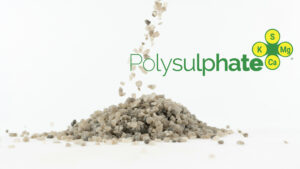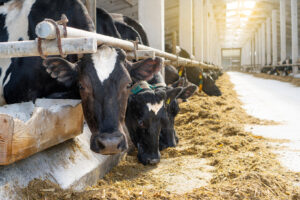Polysulphate grassland trials show increase in forage yield and quality, according to ICL
21st December 2022
As soil sulphur concentrations have declined, with over 90% of UK soils now deficient, awareness has grown of the need to apply this vital nutrient to grassland and forage crops.
Sulphur plays an integral role in nitrogen use efficiency by maximising the true protein content in forage, as well as increasing dry matter, leading overall to greater efficiencies and healthier, more productive stock.
But are all sulphur applications equally effective? Does it matter what form the sulphur is applied in to optimise results?
To find out, ICL have run a series of product trials featuring traditional farm practice nitrogen/sulphur products compared to the mineral fertiliser Polysulphate.
What is Polysulphate?
It is mined as a rock called polyhalite, which is crushed, screened and then marketed as Polysulphate. Certified organic, it has the lowest carbon footprint of any fertiliser on the market, helping farmers to meet the many environmental obligations currently being placed upon them.
Polysulphate consists of 48% SO3 as sulphate, 14% potash (K2O), 17% calcium (CaO) and 6% magnesium (MgO), released over a 50–60 day period, which closely aligns with the nutrient uptake requirements of the crop. This prolonged release mechanism also significantly reduces the potential for sulphate leaching meaning more nutrients remain available for plant uptake, leading to healthier crops from fewer applications.
So, how did it fare in grassland trials compared to traditional farm practice?
Trial conditions
ICL carried out trials at 28 different sites across the UK, including some on organic soils. Sites were split with Polysulphate applied at 100 kg per hectare plus nitrogen on one side and the standard farm practice on the other, which included an ammonium sulphate (AS) application.
Nutrients were matched to ensure any observed effects resulted from the use of Polysulphate as the source of sulphur.
Fresh grass weight was measured in the field and samples were taken for lab analysis.
Results – improved dry matter and sugars
Across the 28 test sites, ICL found that the Polysulphate-treated strips produced on average an 11.24% increase in dry matter compared to the standard farm practice.
Despite significant variations in soil type, geographic region and climate, Polysulphate delivered a dry matter uplift across 87% of the sites tested, consistently outperforming the controls.
Further analysis found that the Polysulphate-treated grass contained on average 9.72% more sugars, making it more palatable to livestock.
Increased Daily Live Weight Gain (DLWG)
Scott Garnett, Head of Agronomy for ICL in the UK and Ireland, said an improvement in the grass N:S ratio resulted in an increase in DLWG for animals grazed on Polysulphate-treated grass.
“The results show a significant increase in dry matter in the grass treated with Polysulphate” he said. “11% is a great result and demonstrates the benefits of the product’s extended release characteristic.
“By dissolving slowly over time and supplying fresh nutrients as the crop requires them, the grass is better able to explore the soil and absorb more nutrients.
“The trials show this leads to denser, heavier, more nutrient-rich forage, and that combined with the increased palatability and digestibility that the extra sugar provides, produces healthier, more productive animals for the same, or potentially less, cost.”
Polysulphate silage trials
Split applications of Polysulphate and AS were made across a 9.2-hectare field. Yield, bale weight and the number of bales were measured after every cut.
The results showed that on average, bales treated with Polysulphate weighed 701 kg, compared to 622 kg from AS treated grass.
Higher yield and more bales per hectare
Polysulphate also produced 30.4 bales per hectare whereas the controls averaged just 26.5 bales. The total number of bales produced across the 4.6 hectares of Polysulphate-treated grass was 140. The AS-treated side generated 122.
Overall, the total yield of grass produced by Polysulphate under the trial conditions was 98,270 kg, compared to 75,905 kg produced on the AS side of the fields.
Cows preferred the sweeter grass
In further work with John Stonehouse at May Farm, Staxton, near Scarborough, ICL looked at the impact of Polysulphate on silage quality.
According to John, the results from the trials reflect his own personal experience.
“The benefits of Polysulphate on silage grass is denser grass, heavier bales and more bales per hectare” he said. On permanent pasture, you’re getting better root structure, so it’s more drought resistant.
“The grass is sweeter and we found that doing trial work where we split the field in half, treating one side with Polysuphate and nitrogen, the other side using ammonium sulphate, when I turned the cows out they ate the Polysulphate side completely first.”
Hear first-hand about John’s experience using Polysulphate.
Importance of sulphur
Hannah Shirt from Lancrop Laboratories in East Yorkshire, explained that true protein levels are higher in sulphur treated grass than in that which has had no sulphur application, due to the improved N:S ratio.
“Sulphur is essential for the production of two amino acids – cysteine and methionine – which are essential for full protein synthesis”, Hannah said.
“Without these, forage has higher levels of non-protein nitrogen, a situation which arises directly as a result of a lack of sulphur.”
Soil acidity
Scott Garnett explained the risk of this is not a problem with Polysulphate because it is pH neutral and has no acidifying effect.
“Increasing the acidity of grassland soils tends to reduce nutrient use efficiency and it also encourages less-productive grass species to take over the sward” says Scott. “Non-acidifying Polysulphate can safely be used as the source of essential sulphate in grassland as the way of ensuring good yields of quality grass and of helping to maintain the presence of clovers”.
To find out more about using Polysulphate on grassland please email plantnutrition@icl-group.com




